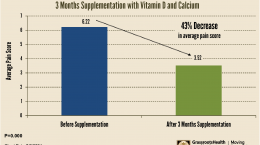Published on August 14, 2024
Learn about several association between vitamin D levels, treatment, and chronic pain in this past webinar with Dr. Linda Rapson, speaker at the upcoming Vitamin D Symposium.
Key Points
- Several consequences of vitamin D deficiency relevant to pain include osteoporosis, osteomalacia, and muscle weakness (also magnesium); possibly also an effect on cartilage and nerves
- Signs and symptoms of vitamin D deficiency include stiffness, muscle/bone pain, muscle weakness (weak grip, difficulty getting out of a chair, problems climbing stairs), unsteady gait/poor balance, stress fractures, neuropathic pain
- One study highlighted in the webinar concluded that muscle weakness is a prominent symptom of vitamin D deficiency, and severely impaired muscle function may be present before biochemical signs of bone disease related to vitamin D deficiency
- Another study found that the highest association between vitamin D level and pain was found for those with leg pain, followed by arthralgia and widespread pain; the association between vitamin D level and pain was stronger among women than men
 Could your vitamin D level contribute to your risk of experiencing chronic pain? The research and experts in practice say yes!
Could your vitamin D level contribute to your risk of experiencing chronic pain? The research and experts in practice say yes!
Dr. Linda Rapson is a medical doctor who has been specializing in the treatment of pain since the early 1990s, and she will be speaking on the topic of “Vitamin D Deficiency and Pain” in the upcoming Empowering Health with Vitamin D symposium, held in Canada on November 1, 2024. (We will be sharing an interview with Dr. Rapson very soon!)
Dr. Rapson has been an influential advocate for the awareness and inclusion of acupuncture and nutrition in mainstream medicine. Her areas of expertise include neuropathic pain in spinal cord injury as well as ubiquitous chronic myofascial pain. Guided by the medical literature on chronic pain, she began testing vitamin D levels in her pain patients in 2004 and was shocked to find very low levels in many of them. Today she continues to advocate for vitamin D in general, not only for pain management, but also for general health. She was a co-winner of the prestigious Dr. Rogers Prize for Excellence in Complementary and Alternative Medicine in 2021 for her leadership in promoting integrative medicine in Canada.
Dr. Rapson did a fantastic webinar on vitamin D and chronic pain in 2013, summarized below. We suggest you view the video to get a taste of what she will be talking about in the upcoming seminar – with over 10 additional years of research and experience to add!
Watch the Video
Key Points from the Webinar
Studies show that low vitamin D levels can be the cause of or an aggravating factor for pain
Many people present with vitamin D deficiency and are unaware of it until they test their blood levels
Governments used to recommend giving children Cod Liver Oil to help provide enough vitamin D for strong bones and the prevention of rickets
Vitamin D supplements are necessary during the winter months in most parts of the world (the further from the equator, the less vitamin D can be made from the sun during the winter)
Consequences of vitamin D deficiency relevant to pain include osteoporosis, osteomalacia, and muscle weakness (also magnesium); possibly also an effect on cartilage and nerves
Signs and symptoms of vitamin D deficiency include stiffness, muscle/bone pain, muscle weakness (weak grip, difficulty getting out of a chair, problems climbing stairs), unsteady gait/poor balance, stress fractures, neuropathic pain
A study by Glerup et al. (2000) looked at muscle weakness in relation to vitamin D deficiency and treatment among patients with osteomalacia – they found that the biggest improvement in muscle power after 3 months of vitamin D supplementation was seen in the weight-bearing, antigravity muscles of the lower limb
The authors also looked at the effect of vitamin D supplementation among Danish women without osteomalacia and found that those who started with vitamin D deficiency had significantly lower muscle function before supplementation compared to those without vitamin D deficiency; supplementation to correct low vitamin D levels resulted in significant improvement in all parameters of muscle function
- STUDY CONCLUSION: Muscle weakness is a prominent symptom of vitamin D deficiency, and severely impaired muscle function may be present before biochemical signs of bone disease related to vitamin D deficiency. High dose vitamin D treatment for at least 6 months is necessary to normalize muscle strength with 25(OH)D testing as a reliable test to determine effectiveness of dosing.
Another study showed that moderate to extreme pain was independently associated with poor vitamin D status
A study by Heidari et al. (2010) looked at 276 patients with nonspecific skeletal pain (including leg pain, widespread pain, arthralgia, rib pain, back pain, fibromyalgia) and compared their vitamin D levels to a control group; there was a significantly positive association between vitamin D level and skeletal pain with deficiency much more prevalent among those with chronic pain
The highest association between vitamin D level and pain was found for those with leg pain, followed by arthralgia and widespread pain; the association between vitamin D level and pain was stronger among women than men
Alarmingly low vitamin D levels found among individuals with fibromyalgia
Study looking at “failed back surgery syndrome” found that vitamin D levels were much lower among those still suffering pain and loss of function after surgery compared to those whose back surgery was successful; treatment with vitamin D resulted in substantial improvement in pain and function
Measure Your Level of Vitamin D
 Having and maintaining healthy vitamin D, magnesium, omega-3s, zinc and other nutrient levels can help improve your health now and for your future. Choose which to measure, such as your vitamin D, omega-3s, and essential minerals including magnesium and zinc, by creating your custom home test kit today. Take steps to improve the status of each of these measurements to benefit your overall health. You can also track your own intakes, symptoms and results to see what works best for YOU.
Having and maintaining healthy vitamin D, magnesium, omega-3s, zinc and other nutrient levels can help improve your health now and for your future. Choose which to measure, such as your vitamin D, omega-3s, and essential minerals including magnesium and zinc, by creating your custom home test kit today. Take steps to improve the status of each of these measurements to benefit your overall health. You can also track your own intakes, symptoms and results to see what works best for YOU.
Enroll and test your levels today, learn what steps to take to improve your status of vitamin D (see below) and other nutrients and blood markers, and take action! By enrolling in the GrassrootsHealth projects, you are not only contributing valuable information to everyone, you are also gaining knowledge about how you could improve your own health through measuring and tracking your nutrient status, and educating yourself on how to improve it.





